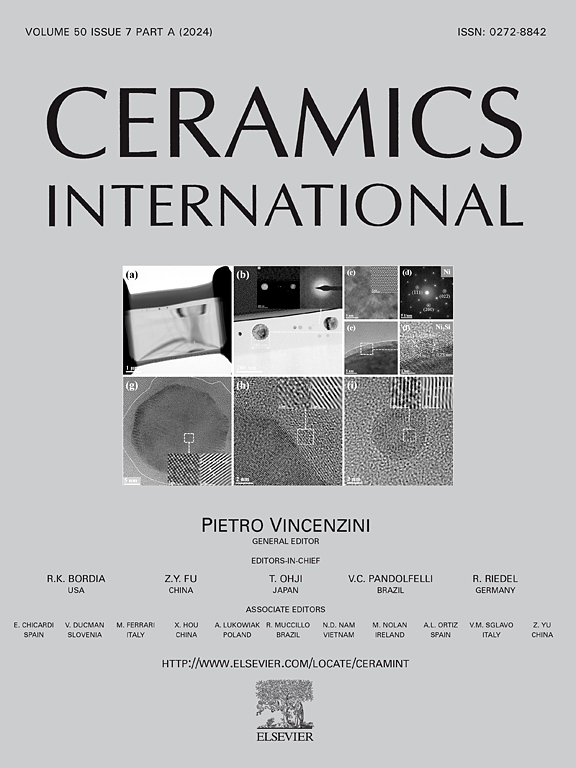在碳基质中植入 MOFs 衍生的硒化铜纳米粒子以实现宽带电磁波吸收
IF 5.1
2区 材料科学
Q1 MATERIALS SCIENCE, CERAMICS
引用次数: 0
摘要
硒化物基功能复合材料具有可调介电性能和异质界面设计,在电磁波吸收领域被广泛研究。本文以 Cu-MOFs 为前驱体,成功制备了金属有机框架(MOFs)衍生的碳包覆硒化铜(Cu2-XSe@C)复合材料。在硒化退火过程中与气态硒反应后,金属宿主被转化为 Cu2-XSe 纳米颗粒,并由有机连接体转化为碳基体。基于调控介电性能和构建异质界面,MOFs 衍生的 Cu2-XSe@C 复合材料显示出卓越的电磁波吸收性能。虽然存在传导损耗、界面和偶极极化行为,但当厚度为 2.0 mm 时,Cu2-XSe@C-600 复合材料在 11.7 GHz 频率下的最小反射损耗(RLmin)值达到了 -74.3 dB。有效吸收带宽(EAB)可通过控制应用厚度来调节。当厚度为 2.3 mm 时,上述 Cu2-XSe@C-600 具有最宽的吸收性能,在 7.7 至 13.2 GHz 范围内的 EAB 为 5.5 GHz,覆盖了整个 X 波段。因此,基于硒化物的 MOFs 衍生复合材料为构建宽带电磁波吸收,尤其是雷达隐身应用提供了一种新的设计策略。本文章由计算机程序翻译,如有差异,请以英文原文为准。
MOFs-derived copper selenides nanoparticles implanted in carbon matrix for broadband electromagnetic wave absorption
Selenide-based functional composites materials demonstrated tunable dielectric properties and heterogeneous interface design, which has been widely studied in electromagnetic (EM) wave absorption field. Herein, Metal-organic frameworks (MOFs) derived carbon coating copper selenide (Cu2-XSe@C) composites were successfully fabricated by using the Cu-MOFs as precursor. After reacting with the gaseous Se in the selenization annealing process, the metal host was converted into the Cu2-XSe nanoparticles, where embodied in the carbon matrix transformed from the organic linker. Based on the tunning dielectric property and building heterogeneous interface, MOFs-derived Cu2-XSe@C composites displayed outstanding EM wave absorption performance. Though the conduction loss, interfacial and dipole polarization behaviors, the minimum reflection loss (RLmin) value of Cu2-XSe@C-600 composites reached to −74.3 dB at 11.7 GHz when the thickness is 2.0 mm. The efficient absorption bandwidth (EAB) can be regulated via controlling the applied thickness. When the thickness is 2.3 mm, above-mentioned Cu2-XSe@C-600 got the broadest absorption performance with the EAB of 5.5 GHz from the 7.7–13.2 GHz, covering the whole X-band. Therefore, MOFs-derived selenide-based composites shed a new design strategy for constructing broadband EM wave absorption, especially in radar stealth applications.
求助全文
通过发布文献求助,成功后即可免费获取论文全文。
去求助
来源期刊

Ceramics International
工程技术-材料科学:硅酸盐
CiteScore
9.40
自引率
15.40%
发文量
4558
审稿时长
25 days
期刊介绍:
Ceramics International covers the science of advanced ceramic materials. The journal encourages contributions that demonstrate how an understanding of the basic chemical and physical phenomena may direct materials design and stimulate ideas for new or improved processing techniques, in order to obtain materials with desired structural features and properties.
Ceramics International covers oxide and non-oxide ceramics, functional glasses, glass ceramics, amorphous inorganic non-metallic materials (and their combinations with metal and organic materials), in the form of particulates, dense or porous bodies, thin/thick films and laminated, graded and composite structures. Process related topics such as ceramic-ceramic joints or joining ceramics with dissimilar materials, as well as surface finishing and conditioning are also covered. Besides traditional processing techniques, manufacturing routes of interest include innovative procedures benefiting from externally applied stresses, electromagnetic fields and energetic beams, as well as top-down and self-assembly nanotechnology approaches. In addition, the journal welcomes submissions on bio-inspired and bio-enabled materials designs, experimentally validated multi scale modelling and simulation for materials design, and the use of the most advanced chemical and physical characterization techniques of structure, properties and behaviour.
Technologically relevant low-dimensional systems are a particular focus of Ceramics International. These include 0, 1 and 2-D nanomaterials (also covering CNTs, graphene and related materials, and diamond-like carbons), their nanocomposites, as well as nano-hybrids and hierarchical multifunctional nanostructures that might integrate molecular, biological and electronic components.
 求助内容:
求助内容: 应助结果提醒方式:
应助结果提醒方式:


